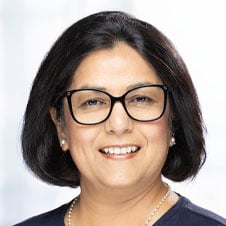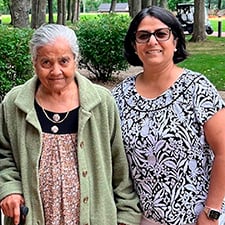There are 322 hospitals affiliated with 133 health systems in 37 states that have been approved by the Centers for Medicare & Medicaid Services (CMS) to participate in its Acute Hospital Care at Home program. But unless Congress takes action, come Jan. 1 the number of “hospital-at-home” programs will fall dramatically.
While most of these programs were started during the COVID-19 public health emergency, the Marshfield Clinic Health System in rural Wisconsin was an early adopter. Psychiatrist Alpa Shah, MD, past chair of the Marshfield Clinic Board of Directors, and was serving on the board when the decision was made to launch its Home Recovery Care program.
Marshfield Clinic is a member of the AMA Health System Program, which provides enterprise solutions to equip leadership, physicians and care teams with resources to help drive the future of medicine.
“In 2016, very few people knew about hospital-at-home or that concept,” said Dr. Shah who serves on the governing council of the AMA Integrated Physician Practice Section.
“The beauty of being an integrated health system and having our own health plan allowed us to move forward with this model before others in the country could,” Dr. Shah said. “It helped us move forward in our commitment to lower the cost of care as well as being innovative in the way we provide care and services to our rural communities—little did I know that I would be experiencing what we were approving as a health system.”
Dr. Shah’s parents live with her and her husband, and it was found that her mother, 82, had a rare spine condition that required surgery and inpatient rehabilitation.
“To our shock, we were told that she was not approved for inpatient rehab, and we would need to look at a skilled nursing facility,” Dr. Shah recalled. “It was scary for us to think about mom going to a nursing home 40–50 miles away, because she speaks limited English, and the logistics were very challenging.”
The logistics would have also included accommodating her 87-year-old father, who “would've wanted to be bedside all the time.”
Instead, Dr. Shah’s mother was able to return home a week after surgery and “it was an unbelievable experience” for the family.
“From the practical standpoint, from the comfort standpoint, from the logistical standpoint, from the care perspective, this was a perfect fit,” Dr. Shah said. “It was so synchronized, so coordinated. Every small detail was carefully looked through, planned for and facilitated.”
A nurse came twice a day. There were visits by physical and occupational therapists, and regular telehealth appointments with physicians.
“From the standpoint of the patient and her recovery, my mom recovered faster and better because she was at home, and the ease and the convenience and the support was phenomenal,” Dr. Shah said. “We don't think there was any compromise in the care that she received because she was recovering at home.”
Congress must take action
Congress needs to extend—or make permanent—a waiver that CMS instituted during the COVID-19 public health emergency that provided flexibility in telehealth regulations and suspended certain Medicare conditions of participation such as having nursing services available 24 hours a day and physical environment regulations. This created a path for greater opportunity to provide acute-care services in patients’ homes.
The waiver expires Dec. 31. If not extended, the number of programs would be greatly reduced. It probably wouldn’t go down to zero as some integrated health organizations, such as Marshfield Clinic Health System, had been operating hospital-at-home programs supported by their own health plans before the CMS waiver was instituted. But programs would be greatly scaled back.
High satisfaction among physicians
Marshfield Clinic’s Home Recovery Care program was one of only about 20 institutions in the nation to offer such a service prior to the waiver. Between 30 to 40 patients per month are admitted to the program.
When it started, some 30 different physicians rotated in and out of the program as the system sought the perfect fit. Four doctors were chosen and Swetha Gudibanda, MD, a hospitalist and medical director of Marshfield Clinic’s Home Recovery Care program, takes it as testament to their job satisfaction that those four are still leading the program’s multidisciplinary care team.
One of the four is hospitalist Sowjanya Bapani, MD, who is also a medical director for the system’s 200,000-member Security Health Plan.
“I’m working on both sides,” Dr. Bapani said, adding that the Medicare waiver facilitated “significant” growth in the program.
Dr. Gudibanda shared some of the program’s outstanding results, including:
- More than 90% patient-satisfaction rate.
- 44% reduction in readmission rate.
- 35% drop in the average length of stay.
“On top of all these things, we have decreased mortality, decreased morbidity and decreased delirium,” she said.
The effort is so effective that Dr. Gudibanda said she wants “to see it everywhere in all health systems throughout the nation, because it's very helpful for our patients, our community and the health system too.”
Marshfield Clinic joined the AMA and more than 60 other hospitals, health systems and medical associations in a letter to congressional leaders urging them to extend the Acute Hospital Care at Home waiver program for at least five more years.
The Acute Hospital Care at Home waiver “is the keystone to the future of home-based care delivery for Medicare patients and beyond,” says the letter (PDF).
“The waiver must be extended to enable hospitals and health systems nationwide to continue building out the logistics, supply chain and workforce for hospital-at-home and to encourage multiple payers outside the Medicare program, including Medicaid programs, to enter the” hospital-at-home market, the letter adds.
Pioneering program flourishes
When the Home Recovery Care program was launched in 2016 as a joint venture initiative between Marshfield Clinic Health System and Contessa Health, a comprehensive care-at-home company, it was one of only about 20 institutions in the nation to offer such a service prior to the waiver.
During the COVID-19 public health emergency, Marshfield Clinic instituted its high-acuity pathway for patients who came to the emergency department, and it involves admitting them for one day to build the foundation for a home care plan.
“We get all the consultations and imaging and then discharge them the next day to complete their hospitalization at home,” said Dr. Gudibanda. “We started this care model when we got the waiver during the pandemic.
“It came in handy for us because we were able to open up a lot of beds for our system and decrease the overhead cost during that time and it helped overcome staff shortages,” she added.
In addition to the program started at its flagship institution, Marshfield Clinic Health System operates Home Recovery Care programs at three of its other facilities. Patients must live within a 30-mile radius of an emergency department to be eligible for the program.
There is also a model in which patients are directly placed in a hospital-at-home program after being discharged from the emergency department or a clinic visit, and another that provides skilled nursing facility-level rehabilitation services at home.
“We are looking into expanding it for palliative hospice patients and thinking about longitudinal care for home-to-home admissions, where they don't even have to come to the ER or urgent care,” said Dr. Gudibanda. “We can just see them virtually and then admit them ‘home-to-home.’”
Also in the works is getting other health plans to cover the program for their members.
As for the CMS waiver, “we're hoping they will make it permanent soon, because once we open this up for all Medicare, all the health plans, it will be a huge thing.”







